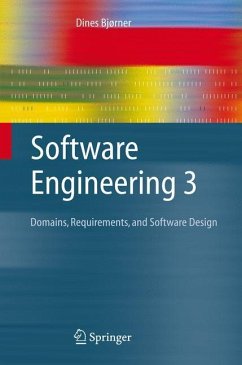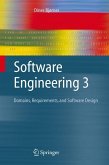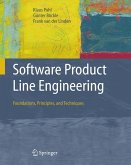The art, craft, discipline, logic, practice, and science of developing large-scale software products needs a believable, professional base. The textbooks in this three-volume set combine informal, engineeringly sound practice with the rigour of formal, mathematics-based approaches.
Volume 3 is based on the maxim: "Before software can be designed its requirements must be well understood, and before the requirements can be expressed properly the domain of the application must be well understood." This book covers the process from the development of domain descriptions, via the derivation of requirements prescriptions from domain models, to the refinement of requirements into software designs, i.e., architectures and component design. Emphasis is placed on what goes into proper domain descriptions and requirements prescriptions, how one acquires and analyses the domain knowledge and requirements expectations, and how one validates and verifies domain and requirements models.
The reader can take an informal route through Vol. 3, and this would be suitable for undergraduate courses on software engineering. Advanced students, lecturers, and researchers may instead follow the formal route through Vol. 3, and in this case Vol. 1 is a prerequisite text. Lecturers will be supported with a comprehensive guide to designing modules based on the textbooks, with solutions to many of the exercises presented, and with a complete set of lecture slides.
Volume 3 is based on the maxim: "Before software can be designed its requirements must be well understood, and before the requirements can be expressed properly the domain of the application must be well understood." This book covers the process from the development of domain descriptions, via the derivation of requirements prescriptions from domain models, to the refinement of requirements into software designs, i.e., architectures and component design. Emphasis is placed on what goes into proper domain descriptions and requirements prescriptions, how one acquires and analyses the domain knowledge and requirements expectations, and how one validates and verifies domain and requirements models.
The reader can take an informal route through Vol. 3, and this would be suitable for undergraduate courses on software engineering. Advanced students, lecturers, and researchers may instead follow the formal route through Vol. 3, and in this case Vol. 1 is a prerequisite text. Lecturers will be supported with a comprehensive guide to designing modules based on the textbooks, with solutions to many of the exercises presented, and with a complete set of lecture slides.
From the reviews: "The presentation is focused on the fundamental ideas of domain engineering, requirements engineering and computer system engineering. ... The rigorous treatment and the author's original style of viewing the software engineering approaches are important, outstanding features ... . is of special interest for both software engineering theorists and practitioners ... . The style is very concise, but at the same time very friendly. ... Undoubtedly, readers coming from a large variety of fields of interest will appreciate the novelty and usefulness ... ." (Tudor Balanescu, Zentralblatt MATH, Vol. 1095 (21), 2006)








